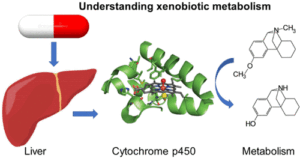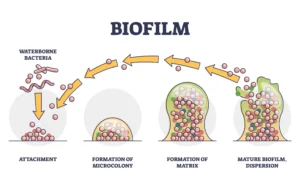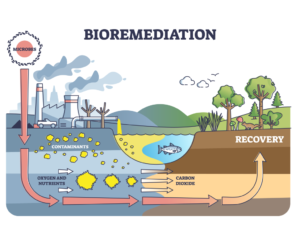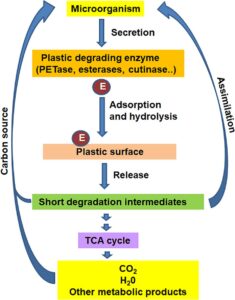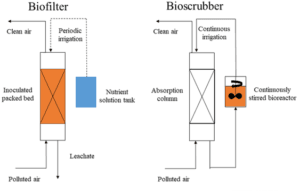Xenobiotics, derived from the Greek words “xeno” (foreign) and “bios” (life), are chemical substances that are not naturally produced or expected within a biological system. They encompass a wide variety of compounds, including drugs, food additives, environmental pollutants, industrial chemicals, and natural toxins. These substances can interact with biological systems in both beneficial and harmful ways, depending on their nature, concentration, and duration of exposure.

Types of Routes of Entry of Xenobiotics.
The routes through which xenobiotics enter the body play a critical role in determining their effects. These routes include:
Inhalation:
- Xenobiotics in gaseous, vapor, aerosol, or particulate forms can be inhaled through the respiratory tract.
- Once inhaled, they can be absorbed into the bloodstream via the alveoli in the lungs.
- Examples include industrial fumes, airborne pollutants, and volatile solvents.
Ingestion:
- The gastrointestinal tract is a common route for xenobiotics entering the body through contaminated food, water, or oral medications.
- After ingestion, these substances are absorbed primarily in the stomach and intestines, entering the bloodstream via the hepatic portal system.
- Examples include pesticides, heavy metals in water, and food preservatives.
Dermal Absorption:
- Some xenobiotics can penetrate the skin’s protective barrier and enter the systemic circulation.
- The extent of absorption depends on factors such as the substance’s lipid solubility, skin integrity, and exposure duration.
- Examples include pesticides, cosmetics, and industrial solvents.
Injection:
- Direct introduction of xenobiotics into the body via injections bypasses natural barriers like the skin and gastrointestinal tract.
- This route can deliver substances directly into the bloodstream (intravenous), muscle (intramuscular), or beneath the skin (subcutaneous).
- Examples include therapeutic drugs, recreational drugs, and venom from stings or bites.
Transplacental Transfer:
- During pregnancy, certain xenobiotics can cross the placental barrier, exposing the developing fetus to potential risks.
- Examples include alcohol, nicotine, certain medications, and environmental toxins.
Each route of entry affects the absorption, distribution, metabolism, and excretion (ADME) of xenobiotics. Understanding these mechanisms is essential for evaluating toxicological risks, designing effective therapeutic agents, and implementing preventive measures to minimize exposure.
Special Features of the Inhalation Route for Xenobiotics
The inhalation route is unique compared to other routes of entry due to several anatomical and physiological characteristics of the respiratory system. These features make it a highly efficient pathway for the absorption of xenobiotics, particularly those in gaseous, vapor, or particulate forms. Key aspects include:
Large Surface Area:
- The alveolar region of the lungs provides an extensive surface area (approximately 70-100 square meters in adults) for the exchange of gases and absorption of xenobiotics.
Rich Blood Supply:
- The lungs are highly vascularized, ensuring rapid diffusion of inhaled substances into the bloodstream. This allows xenobiotics to enter systemic circulation almost immediately.
Thin Alveolar-Capillary Barrier:
- The barrier between the alveoli and capillaries is only 0.5-1.0 micrometers thick, facilitating efficient diffusion of small molecules and gases.
Rapid Onset of Action:
- Substances absorbed via the inhalation route can quickly reach target organs due to the direct connection between the lungs and systemic circulation. This makes the inhalation route particularly effective for delivering drugs like anesthetics.
Direct Access to the Brain:
- Some xenobiotics can bypass the blood-brain barrier via the olfactory and trigeminal nerves, providing a direct route to the central nervous system.
No First-Pass Metabolism:
- Unlike the ingestion route, substances absorbed through the lungs bypass the liver’s first-pass metabolism, resulting in higher bioavailability of the xenobiotic.
Exposure to Airborne Pollutants:
- The inhalation route makes the body highly susceptible to environmental pollutants, occupational hazards, and airborne toxins, which can cause respiratory and systemic effects.
Particle Size Dependence:
- The efficiency of absorption depends on the size of the inhaled particles:
- Large particles (>10 μm) are trapped in the nasal passages.
- Medium-sized particles (2-10 μm) settle in the bronchi and bronchioles.
- Small particles (<2 μm) reach the alveolar region for absorption.
Due to these unique features, the inhalation route is a critical pathway for both therapeutic applications (e.g., inhalers for asthma) and toxicological concerns (e.g., exposure to industrial chemicals or air pollution). Understanding its mechanisms is essential for evaluating health risks and developing protective strategies.
Special Features of the Ingestion Route for Xenobiotics
The ingestion route is one of the most common ways xenobiotics enter the body, particularly through contaminated food, water, or oral medications. Several characteristics make this route distinct from others, particularly in how xenobiotics are processed and absorbed. Key features include:
Role of the Gastrointestinal (GI) Tract:
- The ingestion route involves the GI tract, a complex system specialized in breaking down, absorbing, and metabolizing nutrients, as well as xenobiotics.
- Absorption primarily occurs in the stomach and intestines, with the small intestine playing a major role due to its large surface area.
Large Surface Area for Absorption:
- The small intestine has villi and microvilli, collectively forming the brush border, which significantly increases the surface area for absorption.
First-Pass Metabolism:
- Substances absorbed through the GI tract are transported via the hepatic portal vein to the liver before reaching systemic circulation.
- This process, called first-pass metabolism, can significantly reduce the bioavailability of some xenobiotics by metabolizing them in the liver before they exert systemic effects.
Influence of pH:
- The pH varies across the GI tract, affecting the solubility and ionization of xenobiotics:
- Weak acids are better absorbed in the stomach (low pH).
- Weak bases are better absorbed in the intestines (higher pH).
Varied Absorption Rates:
- The rate of absorption depends on the physicochemical properties of the xenobiotic, such as its lipophilicity, molecular size, and ionization state.
- Lipid-soluble compounds are absorbed more efficiently than water-soluble ones.
Potential for Delayed Effects:
- The ingestion route often leads to a delayed onset of action compared to inhalation or injection, as substances must pass through the digestive and metabolic processes before entering systemic circulation.
Interaction with Digestive Processes:
- Xenobiotics may interact with digestive enzymes, bile salts, and gut microbiota, altering their absorption and metabolism.
Impact of Food and Diet:
- The presence of food can influence the absorption of xenobiotics:
- Some are absorbed better with food (e.g., lipid-soluble vitamins).
- Others may have reduced absorption due to competition or binding with food components.
Susceptibility to Contaminants:
- The ingestion route is a major source of exposure to environmental toxins, pesticides, and heavy metals through contaminated food and water.
Systemic Exposure via Liver:
- While the liver’s role in detoxification is beneficial, it can sometimes activate xenobiotics into more toxic metabolites, increasing their potential for harm.
The ingestion route’s complexity highlights the importance of understanding how xenobiotics interact with the digestive system and the liver to predict their absorption, metabolism, and overall impact on health.
Special Features of the Dermal Absorption Route for Xenobiotics
The dermal absorption route allows xenobiotics to enter the body through the skin, making it a unique pathway compared to other routes. It plays a significant role in exposure to chemicals in occupational, environmental, and therapeutic settings. The special features of this route include:
Barrier Function of the Skin:
- The skin, particularly the outermost layer (stratum corneum), serves as a natural barrier to protect the body from environmental hazards.
- Despite its barrier role, certain xenobiotics can penetrate the skin, especially if they are lipid-soluble.
Multiple Layers with Unique Roles:
- The skin consists of three primary layers:
- Epidermis: The outer layer, where the stratum corneum provides the main barrier.
- Dermis: Rich in blood vessels and connective tissue, allowing absorbed xenobiotics to enter the systemic circulation.
- Hypodermis (Subcutaneous Tissue): Stores fat, which can act as a reservoir for lipophilic substances.
Lipophilicity-Dependent Absorption:
- Lipid-soluble substances penetrate the skin more effectively due to their ability to dissolve in the lipid matrix of the stratum corneum.
- Water-soluble substances generally have lower absorption rates.
Surface Area and Exposure Time:
- The extent of dermal absorption depends on the skin’s surface area and the duration of exposure. Larger exposed areas or prolonged contact increase absorption.
Influence of Skin Condition:
- The condition of the skin significantly affects absorption:
- Damaged or broken skin (e.g., cuts, burns) enhances absorption.
- Hydrated or occluded skin (e.g., covered with a bandage) also increases permeability.
Absence of First-Pass Metabolism:
- Xenobiotics absorbed through the skin bypass the liver’s first-pass metabolism, entering the systemic circulation directly through the dermis. This increases bioavailability compared to oral routes.
Localized vs. Systemic Effects:
- Dermal absorption can lead to localized effects (e.g., skin irritation or burns) or systemic effects if the xenobiotic reaches the bloodstream.
- Example: Topical medications for localized treatment versus transdermal patches for systemic drug delivery (e.g., nicotine or hormone patches).
Reservoir Effect on the Skin:
- The skin can act as a reservoir for certain xenobiotics, slowly releasing them into the body over time, leading to prolonged exposure.
Susceptibility in Specific Areas:
- Thin-skinned areas (e.g., face, groin) are more permeable and absorb xenobiotics more efficiently than thicker-skinned areas (e.g., palms, soles).
Exposure to Environmental and Occupational Hazards:
- Dermal absorption is a significant route of exposure to pesticides, industrial chemicals, and solvents in occupational and environmental settings.
The dermal absorption route is particularly important in toxicology and pharmacology for understanding chemical exposure risks, designing transdermal drug delivery systems, and implementing protective measures against hazardous substances.
Special Features of the Injection Route for Xenobiotics
The injection route is a unique and highly effective method for introducing xenobiotics directly into the body. It bypasses natural barriers such as the skin, gastrointestinal tract, and lungs, enabling precise control over the dose and delivery location. The injection route has the following special features:
Direct Entry into the Body:
- Injection allows xenobiotics to bypass absorption barriers and enter specific tissues or the bloodstream directly.
- This ensures rapid delivery to target sites or systemic circulation.
Rapid Onset of Action:
- Since xenobiotics are directly introduced, their effects are often immediate or occur within a very short time.
- Intravenous (IV) injections, in particular, deliver substances directly to the bloodstream, leading to almost instantaneous effects.
Precise Dose Control:
- Injections provide accurate dosing without the variability associated with absorption in oral or dermal routes.
- This is crucial for medications requiring tight control, such as insulin or chemotherapy drugs.
Bypasses First-Pass Metabolism:
- Unlike the oral route, injections avoid first-pass metabolism in the liver, ensuring higher bioavailability of the xenobiotic.
Variety of Injection Methods:
- Different types of injections offer varying effects and absorption rates:
- Intravenous (IV): Direct delivery into the bloodstream for immediate systemic effects.
- Intramuscular (IM): Slower absorption compared to IV; used for depot injections or sustained release.
- Subcutaneous (SC): Absorption into the bloodstream is slower than IM; used for insulin and vaccines.
- Intradermal (ID): Superficial injection into the dermis; used for diagnostic tests like the tuberculin skin test.
- Intra-articular or Intrathecal: Direct delivery to joints or the spinal canal for localized effects.
Localized or Systemic Effects:
- Injections can be used for localized effects (e.g., anesthetics for surgery) or systemic effects (e.g., antibiotics for infections).
Ability to Administer Complex Substances:
- Biologics, vaccines, and protein-based drugs, which may degrade in the gastrointestinal tract, can be administered effectively through injections.
Use in Emergency Situations:
- Injections are the preferred route for emergency treatments, such as adrenaline in anaphylaxis or naloxone for opioid overdose, due to their rapid action.
Risk of Complications:
- Although effective, the injection route carries risks such as:
- Infection: Due to breaches in the skin barrier.
- Tissue Damage: If administered incorrectly.
- Adverse Reactions: Rapid onset increases the risk of severe side effects or toxicity.
No Dependency on Patient Compliance:
- Injections are administered by healthcare professionals or through devices (e.g., auto-injectors), ensuring the correct dose is delivered, independent of patient compliance.
Controlled Release Possibilities:
- Depot injections or implants allow for the sustained release of xenobiotics over days, weeks, or months, reducing the need for frequent dosing.
The injection route’s versatility and efficiency make it indispensable in medical and therapeutic applications, especially when rapid action, precise dosing, or delivery of complex substances is required. However, its invasive nature demands careful handling and administration to minimize risks.
Special Features of the Transplacental Transfer Route for Xenobiotics
The transplacental transfer route involves the passage of substances from the maternal circulation through the placenta to the fetus. This route is particularly significant in the context of pregnancy and fetal development. Several factors make it unique, especially concerning the transfer of xenobiotics, nutrients, and waste products between the mother and the fetus. Key features include:
Placental Barrier:
- The placenta acts as a selective barrier between the maternal and fetal circulations. While it facilitates the exchange of nutrients and oxygen, it also prevents the passage of certain harmful substances, but some xenobiotics can still cross.
Molecular Size and Lipophilicity:
- The ability of xenobiotics to cross the placental barrier largely depends on their molecular size and lipophilicity:
- Smaller, lipophilic (fat-soluble) molecules are more likely to pass from the maternal bloodstream to the fetal circulation.
- Larger or hydrophilic (water-soluble) molecules are less likely to cross, though some may still be transported via specific transporters.
Active Transport and Facilitated Diffusion:
- Certain xenobiotics, such as amino acids, vitamins, and drugs, can be actively transported or pass through facilitated diffusion. Specific transporters in the placenta play a key role in the movement of substances.
- This process can result in the selective transfer of xenobiotics, sometimes concentrating them in the fetal circulation.
Developmental Sensitivity:
- The fetus is particularly vulnerable to xenobiotics during certain stages of development, especially in the early stages when organogenesis is occurring.
- Teratogenic substances (e.g., certain medications, alcohol, tobacco smoke) can cause birth defects, developmental delays, or other adverse outcomes.
Transfer of Lipid-Soluble Substances:
- Lipophilic xenobiotics, such as many environmental pollutants (e.g., pesticides, heavy metals, certain drugs), can readily cross the placenta and accumulate in the fetus.
- These substances may have long-lasting effects on fetal development and may even remain in fetal tissues for an extended period.
Influence of Maternal Physiology:
- Maternal factors, such as blood flow, metabolism, and the presence of other substances (e.g., drugs, nutrients), can affect the rate and extent of transplacental transfer.
- For example, maternal diseases, liver function, or use of certain medications may increase or decrease the transfer of xenobiotics to the fetus.
Placental Enzyme Systems:
- The placenta contains enzymes that can metabolize some xenobiotics, potentially transforming them into more or less toxic forms.
- This metabolic activity can alter the concentrations of xenobiotics available to the fetus, though the fetus’s ability to metabolize substances is less developed than the mother’s.
Potential for Accumulation in Fetal Tissues:
- Some xenobiotics, especially those that are lipophilic, can accumulate in fetal tissues, including the brain, liver, and adipose tissue, leading to long-term exposure and potential toxicity.
- This accumulation is of particular concern for substances that have a prolonged half-life, such as certain heavy metals (e.g., lead, mercury) or fat-soluble pesticides.
Protection Mechanisms:
- The placenta has protective mechanisms, such as the expression of certain efflux transporters (e.g., P-glycoprotein), that can actively pump certain xenobiotics back into the maternal circulation, preventing excessive fetal exposure.
- However, these protective mechanisms are not always fully effective, particularly for highly toxic or lipophilic substances.
Implications for Drug Safety:
- Drugs taken by the mother can cross the placenta and affect the fetus, making it critical to consider drug safety during pregnancy.
- Some medications are contraindicated during pregnancy due to potential teratogenic or developmental effects, while others may be used under medical supervision if the benefits outweigh the risks.
The transplacental transfer route is critical in understanding how environmental toxins, drugs, and other substances can impact fetal development. Its selective nature offers some protection but also presents risks, especially for substances that the fetus may be particularly sensitive to, making the management of maternal exposures crucial during pregnancy.


